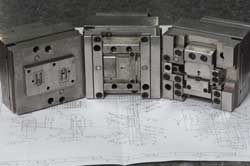Maybe everything is bigger in Texas, and maybe that’s the way they like it. But in most parts of the world, the opposite is often true — particularly when it comes to technology. Over the past couple of decades we’ve seen phones get smaller even as they take on dozens of different functions. Computers have shrunk in size and weight, despite ever expanding hard drives capable of storing virtually limitless amounts of data. Even larger equipment like printers and scanners seem to be shrinking.
Many consumers may not realize it, but the massive potential of these devices is dependent upon miniscule parts that must be engineered to precise specifications. Even minor variations in their design from one product to the next could create a wave of complications and even render the device completely useless. To accomplish this consistent, intricate creation of micro-products, businesses have employed a technique known as micro molding.
Micro molding process
Micro molding is the name given to a manufacturing process that produces parts and products weighing less than a gram. This technique is used thanks to an injection press, which has become a widely used piece of equipment across many different manufacturers of products.
The manufacturing process typically involves the use of plastic as the main material. To produce these parts, heated materials are forced into a barrel where they are mixed together and injected into a mold cavity. Once the materials have cooled and hardened in the shape of the mold cavity, the part is ready to be implemented or utilized in other manufacturing processes.
By using identical molds, parts can be continually produced with no variance whatsoever in relation to the rest of the production line. Injection molding is implemented on much larger scales, such as to produce parts for cars, but micro-molding is a much more recent development that can be credited with the slim profile of your powerful smart phones.
Assuring product consistency and quality
Because these micro parts can derail a product altogether, and because defects in the production of these parts is often undetectable to the human eye, quality assurance measures are essential. Many micro molding companies implement several types of quality assurance to minimize the risk of defective parts weakening a product.
Many of these quality assurance measures begin before the product is even produced — reviews of product designs are conducted to make sure that the design is correct and that production can go on without any hiccups.
In many cases, a battery of high and low-tech quality assurance measures are taken, employing high resolution in-line vision systems and precision gauge pins, among other products, to evaluate what the human eye cannot see. The dimensions of the finished product are also measured to make sure that it has come out of the mold with the proper size specifications.
Finally, steps are taken to minimize surface contamination of the products, which can pose serious problems down the line as dust, dirt and other contaminants interfere with the intended function of the product. These steps are necessary to ensure that expensive tech gadgets do not later face recall due to internal defects. Product malfunctions at the micro level can be very frustrating and costly, making prevention a key goal of most operations. But consumers also benefit by enjoying tested tech products that face a low risk of internal parts defects.



